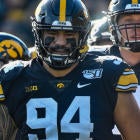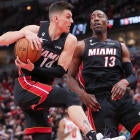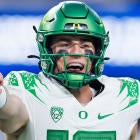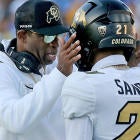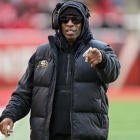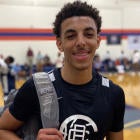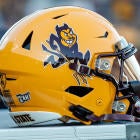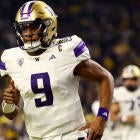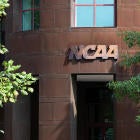The Buffalo Bills added youth, versatility, and power to their already stout defensive line by drafting Iowa's A.J. Epenesa at No. 54 overall in the second round of the 2020 NFL Draft, but the biggest thing they did this offseason, including in the draft, is upgrade at receiver. The trade for Stefon Diggs in March provided the offense a true No. 1 receiver to round out an improved receiver group from a season ago that saw John Brown eclipse the 1,000-yard mark and Cole Beasley record the second-best statistical season of his career. Because Brown and Beasley are both 30, Buffalo doubled up on receiver in the loaded draft class by landing 6-foot-2 Gabriel Davis from UCF in Round 4 and 6-4 Isaiah Hodgins from Oregon State in Round 6.
Stocking the receiver shelves for Josh Allen was a shrewd decision by Buffalo's front office, especially with how prevalent three or more wideout sets have become in the modern NFL. Per Sharp Football Stats, the NFL as a whole has utilized three or more receiver formations at least 63% of the time in each of the past four seasons. In 2019, the Bills utilized "11 Personnel" -- just three receivers on the field -- 70% of the time, a rate that tied for the seventh-highest in the league.
Buffalo has completely revamped the receiver position over the past two years and boasts one of the deepest defensive fronts in all of football. But let's take a look at what the Buffalo failed to do in the draft. Addressing these issues before Week 1 could help the Bills become a Super Bowl contender.
1. Find a "big nickel" defender
With coverage-specialist linebackers Matt Milano and Tremaine Edmunds, Buffalo didn't enter the 2020 draft with a major need at "big nickel," but for a team that utilized the nickel package 76% of the time in 2019 per Sports Info Solutions, finding a defender with linebacker-like run-halting skills and safety-esque coverage ability to play next to Milano and Edmunds was a priority with the long-term future in mind.
The Bills tried 2017 fifth-round pick Siran Neal at the hybrid position for short stretches with average-at-best results. In a draft class featuring a variety of big nickel candidates, most namely Kyle Dugger and Jeremy Chinn, many believed the Bills would address the minor need with a marquee talent in the draft.
Didn't happen.
Buffalo decided to pass on ideal big nickel prospect Chinn to pick Epenesa in Round 2. Sensible decision. In Round 3, cornerback turned safety Julian Blackmon -- not exactly a big nickel prototype -- went a pick before the Bills grabbed Moss. Then, in Round 4, safety/cornerback hybrid K'Von Wallace who flourishes against the run because of his assertiveness and tackling reliability, went a pick before Buffalo chose Davis. Possible big nickel defender Daniel Thomas from Auburn was chosen 10 selections ahead of Jake Fromm in the fifth round.
In Round 6, Notre Dame's big nickel safety Alohi Gilman went two picks in front of the Bills. Maryland's Antoine Brooks was still on the board and ultimately was selected 10 picks after Buffalo opted for kicker Tyler Bass.
As more offenses utilize more two tight end sets, defenses will be forced to counter with larger nickel defenders over the small slot cornerbacks who, for years now, have manned up against tiny, quick slot receivers. Available free agents who could jump into at least a competition for this niche role include Tavon Wilson, Clayton Geathers, and Tony Jefferson. Another possibility for Buffalo: 2019 sixth-round pick Jaquan Johnson, who starred in the preseason, gets an opportunity to man the role, although he's on the small side for a big nickel defender.
2. Draft long-term options for the right side of the offensive line
For the upcoming season, there's actually a logjam at right guard and right tackle with returning starter Jon Feliciano (RG) back along with split-starters at right tackle Ty Nsekhe and Cody Ford. However, Nsekhe turns 36 this year. And as Nsekhe's replacement after an injury, Ford was mostly a liability protecting the edge. Given his size, power, and lack of explosiveness in pass protection, his best position long-term is likely inside at guard. Also, former Panthers standout Daryl Williams was brought in on a one-year deal.
As for Feliciano, he was a steady albeit unspectacular full-time player in 2019 and enters the final year of the two-year pact he signed with Buffalo before last season.
Bills GM Brandon Beane told reporters after the draft that although nothing was ever finalized, the Bills were in talks with a few teams to trade up for an offensive lineman on Day 3, and Ryan Talbot of NYUp.com narrowed it down to Kentucky's mauling guard Logan Stenberg or Fresno State's ultra-powerful guard/tackle Netane Muti as the most likely prospects Beane was interested in.
While we'll probably never know which offensive line prospect Beane coveted but was unable to make a move to land, it shows the GM's desire to bolster the long-term sustainability of Buffalo's offensive front.
Finding quality blockers on the free-agent market post-draft is extremely difficult; therefore, Buffalo's best option at this point may be to continue to develop Ryan Bates, a versatile blocker Beane traded for last August who tested well at last year's combine.
3. Get another viable receiving tight end
The Bills got aggressive in the third round of the 2019 draft, trading both fourth-round picks to move up for Ole Miss tight end Dawson Knox. Playing in an offense with A.J. Brown and DK Metcalf, Knox was overshadowed as a pass catcher and caught only a total of 39 passes for 605 yards without a touchdown in his two seasons a full-time contributor for the Rebels.
He had a respectable combine workout, and his athletic gifts allowed him to flash down the field and after the catch as a rookie, but Knox never had more than four receptions in a single game and had three receptions just twice. While his rookie campaign was encouraging, especially for someone hardly utilized in the pass game in college, he didn't have a debut NFL season that should have staved off any incoming competition at tight end.
But the Bills didn't pick a tight end -- albeit in a weak class. Fellow 2019 draft pick Tommy Sweeney remains on the roster, as does blocking-specialist Lee Smith, who was a penalty liability last season. It's not crazy to assume the latter will have his work cut out for him to make the team. Tyler Kroft was sidelined most of the 2019 campaign with injury and only caught six passes for 71 yards and one touchdown on 14 targets. He's had an exceedingly difficult time staying healthy of late and has just 10 catches over the past two years. While not completely out of the question, it's hard to assume Kroft will take on a sizable role in 2020.
Without a viable receiving threat at the tight end position on the free-agent market, the Bills will likely have to make do with Sweeney as the primary backup to Knox. Or maybe they're hoping for more pass-game contributions from Jason Croom, who made a few splash plays in 2018 but dealt with injuries all last year.













